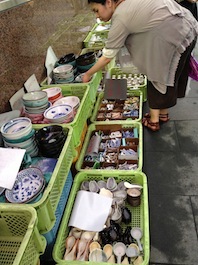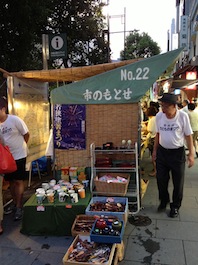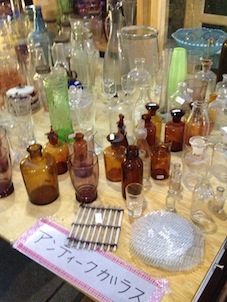



Setono City (finished this year)
Chuo-ku Tourism Association Official Blog
List of AuthorsRecent blog post
|
Semono City
If you recall, this season just a year ago. I was looking for a room to move to a new land because the apartment I lived at that time was approaching.
It has been 10 years since I worked part-time in Ginza and Tsukiji when I was a student and thought, "I want to live in Chuo-ku in the future." Like the phrase I heard somewhere, "Yes, let's move to Chuo-ku." At this time of last year, I got on the Hanzomon Line from Omotesando where I worked and got off at Suitengumae Station.
The road to the Ningyocho intersection where the target real estate agent is located, and the sidewalk along Ningyocho-dori was steamed back and was crowded with many people. The city was being held. I arrived at the real estate agent while feeling "this air is good after all." I was planning to look for other areas, but first I was introduced to some properties in the Ningyocho neighborhood. After all, I was glad to believe in my intuition ... I didn't find it in other areas. It wasn't a mistake, I moved to Chuo-ku. Every day is fun.
And the preposition becomes longer and Sumimasen. This year, the time of "Setono City" has come. It is held every year from January to Wednesday in August, and this year is three days from 5th to 7th. It overlapped with overtime, so I was able to see it only on the 6th (Tuesday).
   From the Suitengumae intersection to the Ningyocho intersection, tents of dealers line up on both sides of Ningyocho-dori. When I'm excited
Soba Inoguchi and small plates used in the Edo period. The slightly dull dyeing is tasteful and beautiful. I saw the simple appearance, such as glass made during the Meiji and Taisho eras. I thought the soba inoguchi was also affordable, but this time I bought glassware.
 Not only ceramics, but glass and wood products were also sold. It's also nice to use different dishes for each season. In front of Daikanonji Temple, it seemed that you could experience an electric potter's wheel. Please find your favorite in the city of Setomono next year. The ice yokan of Judo is also delicious.
Setono City (finished this year) Held every year from January to Wednesday, August
Get off at Ningyocho Station on the Tokyo Metro Hibiya Line or Suitengumae Station on the Hanzomon Line.
Beginning of August Noryo Kabuki
August 2 The curtain of the first day of "Nyo-kabuki" has opened. Kabukiza, which has been prosperous since the opening of the new store in April, has the word "large entry" in the middle of the goods today.
It's been a long time since I saw it on the first day, and I'm thrilled. There are also many actors near the reception. It's the first day. Today we watch Part 3 "Fox Fox Fox Fox Bananashi" and "Stick Shibari". "Fox Fox Fox Fox Bananashi" is a kabuki of comedy by Shuji Hojo. "Eh!" with a donden return of being deceived or deceived "Ah!" I never stop laughing from the audience. It is strange that Hashinosuke, a raw odor shaven who was approached by `` Osome '' played by Kamezo called `` Ushimusume '', desperately endures the laughter coming up with Kamezo's tremendous expression. I'm blowing out together. When the cheerful appearance of Utae Nakamura (81 years old) appears in the young team, the voice of "Narukomaya!" "Bashibari" is a humorous popular dance that has been performed many times in the combination of Goro Mitsu and Kansaburo who died, but this time it will be played by Goro Mitsu and Kankuro. "Fox raccoon Fox Fox Bananashi" is also a performance performed by Kansaburo of the 17th and 18th generations. Obon is also approaching. I laughed a little while laughing when I thought that they might be talking about "I'm still far away" or saying "Don't do it!" . Please come and see the activities of young flower-shaped actors blowing away the heat.
Part 1 "Nozaki Village" and "Spring Kogami Lion" started at 11:00 Part 2 "Shinzo Hairyu" and "Kasane" starts at 14:15
Tickethon Shochiku 0570-000-489 (10: 00-18: 00) Senakiraku 24th
Toshodaiji Temple ~ Kanmawakami 1250 (Nara Mahorobakan)
This year is the founder of Toshodaiji Temple, the 1250-year-old Oyo (Gyoki) in Kanmawakami. In 1250, Oyo is 1250 years after Kanma Kazugami died, and the great law is held once every 50 years.
If you're planning a trip to Nara, why not get tourist information at Nara Mahorobakan? There is also a special product corner and a cafe corner.
http://www.mahoroba-kan.jp/ (http://www.mahoroba-kan.jp/)
"Minatoya Ezoku Paper Store" in Hamacho
"Minatoya Painting Paper Shop"--It's a name I've heard somewhere.
Yes, it's the name of the store that Yumeji Takehisa opened in Nihonbashi Gofukumachi (now Yaesu 1-chome) in 1914.
On the other side of Kiyosubashi-dori in front of the temporary palace of Suitengu opposite Meijiza, there is a shop called "Minatoya Ezoku Paper Shop". The frontage is about one-way shop, but inside, there are lots of Japanese miscellaneous goods such as prints and postcards drawn by Yumeji Takehisa, fans with the signature of Yumeji, letter sets, etc.
In this shop, "GALLERY Minatoya", which specializes in Yumeji Takehisa's works, has been selling Japanese miscellaneous goods as a "Minatoya Ezoku Paper Store" for more than 20 years with the consent of Yumeji Takehisa's bereaved family.
When a woman enters, there are various miscellaneous goods and it is likely to be noticeable, and it is cute and I can't help but buy something. Please take a look when you come to Meijiza or Suitengu Shrine. GALLERY Minatoya URL:www.yumeji-minatoya.co.jp Strolling around Ginza 5-8chome II
Here is a continuation of the blog "Ginza 5-8-chome Walking I" introduced last time Click here for the previous article. →
This is the place shown in bold letters
<line So far > Ginza Station: Monument of Sukiyabashi ... Toya Kitamura & Toson Shimazaki Monument ... Takuboku Ishikawa poetry monument ... Pedestrian paradise ... Ruins of the commercial law workshop ... Kinharu Yashiki Ruins of Ginza Brick remain Monument ... Monument of Ginza willow ... Shibakuchi Gomon Ruins of Sanumabori Ruins ... Former Japanese National Railways railroad crossing signal at Tokyo Information Center ... Site of Sakujom ...
As a continuation of the previous time, three large stones next to the explanation board of the site of Sanjumabori. These are at the exit of the highway. It's hard to understand.
Land at the beginning of modern goods purchase inspection In 1876 (1876) An insulator laboratory in the Ministry of Engineering's telegraph dormitory will conduct an electrical test of electrical insulators for telegraphs here.
1878, Meiji 11 (1878), Japan's first Chamber of Commerce The Tokyo Commercial Code Chamber will be established. This monument was erected at the birthplace to commemorate the 100th anniversary of its founding. There is Shimbashi Enbujo on the left side. It's easy to overlook.
In Kaei era 4 <1851>, he opened a military school to give lectures on military science, artillery, and maritime defense measures.
The shogunate's wife. Yotsuya Kano. It was the Kano family in Kobiki-cho that flourished.
As mentioned above, it was a walk around Ginza 5-8-chome
Bon Odori in Ginza
One of the most important events in summer is Bon Odori in fireworks festival.
At the venue, there were stalls such as yakisoba, Frank, drinks and ice by the town council members, but it is possible to see neighbors' office workers and OLs mixed with people in yukata. It's just like this land.
|
MenuArchiveLinks |